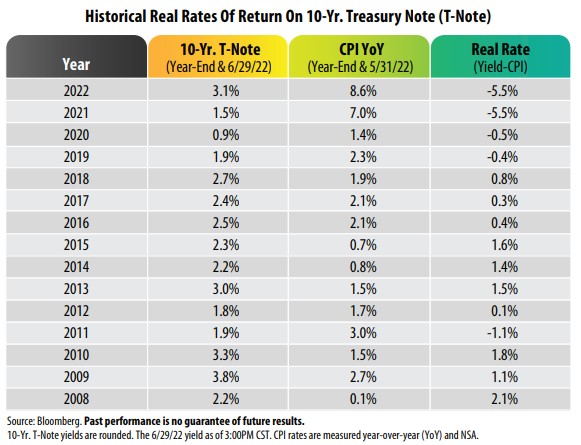
View from the Observation Deck
1. The real rate of return on a bond is calculated by subtracting the most recent inflation rate, such as the Consumer Price Index (CPI), from the bond's current yield. The higher the real rate the better.
2. As of 3:00PM CST on 6/29/22, the yield on the benchmark 10-year T-note was 3.09% (3.1% rounded), well below the 8.6% trailing 12-month rate on the CPI in May 2022. That equates to a real rate of -5.5%, which is not attractive.
3. In addition, the real rate was unchanged from the end of 2021 despite the yield on the 10-year T-note spiking by 158 basis points over the period. The CPI nearly matched it with a 150 basis point move.
4. At a base level, in order to maintain one's purchasing power, bond investors have sought to generate a yield that at least outpaces the rate of inflation.
5. For comparative purposes, from 6/29/92 through 6/29/22 (30 years), the average yield on the 10-year T-note was 3.95% (4.0% rounded), while the average rate on the CPI stood at 2.4% (5/31/92-5/31/22), according to Bloomberg. Those figures translate into an average real rate of return of 1.6%, far more attractive than currently available. These would be considered normalized yields/rates, in our opinion.
6. As of 6/29/22, the federal funds target rate (upper bound) stood at 1.75%, up from 0.25% at the start of the year. The Fed has signaled that it intends to raise this benchmark lending rate by another 50-75 basis points at its next meeting on 7/27/22 and could take the rate above the 3.00% mark by year-end.
7. The federal funds target rate (upper bound) averaged 2.46% for the 30-year period ended 6/29/22. That is line with the 2.4% average rate on the CPI for the 30-year period ended 5/31/22 (see Point 5).



